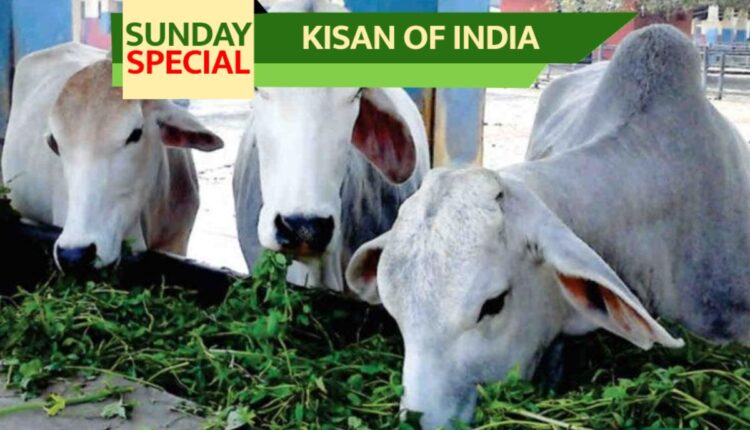Animal Feed: Why the country needs a massive feed revolution now?
Fodder production is an important area for farmers to increase their income as there is acute shortage of balanced cattle feed in the country apart from dry and green fodder.
Animal Feed | The time has come on the lines of the Green Revolution, White Revolution, and Blue Revolution. The Indian agricultural economy should now rapidly move forward in the direction of the fodder revolution. Because India may lead the world with about 540 million livestock, it has also long been on top of global milk production. Even though the annual growth rate of animals in the country is 7.9%, the government cannot meet the demand. There is still a shortage of about 36 percent green fodder, 11 percent dry fodder, and a 44 percent shortage of balanced animal feed.
Scientists of ICAR-Indian Grassland and Fodder Research Institute (IGFRI) or Indian Grassland and Fodder Research Institute, Jhansi, estimate that even by the year 2050, there will be a shortage of 18.4 percent green fodder and 13.2 percent dry fodder in the country. Green grass cultivation and balanced animal feed production are areas with solid opportunities for farmers to earn well. So, more and more farmers should try their hard work and skills in animal feed production.
Livestock is the livelihood of 2 crore people in the country
Livestock and animal husbandry account for 28.63 percent of the Indian agricultural economy. The country’s livelihood of more than two crore population is directly or indirectly dependent on livestock and animal husbandry. The contribution of animal husbandry to the income of small farmers is about 16 percent. In comparison, the share of livestock and animal husbandry in the total income of the rural population is about 14 percent. Of this, two-thirds of the rural population’s income comes from livestock products.
Livestock and animal husbandry significantly contribute to the country’s agricultural economy. There are 12.6 crore total milch animals, including cows and buffaloes, in the country. There are about 11 crore buffaloes in these, the highest in the world. India also ranks second and third in the world in the number of goats and sheep, respectively. But in contrast to these achievements, the status of Indian animal husbandry is far behind other countries, even in terms of livestock production.
India is 30% behind in livestock productivity
According to the 20th Cattle Census Report 2019, while the global average annual milk productivity of bovine animals in the country is 2,238 kg, the milk yield of Indian cattle is only 68.7 percent i.e. 1,538 kg annually. Compared to the average global productivity of livestock, India’s achievement lags by about 30%, which is certainly very worrying. For this outbreak of various diseases, livestock can be held responsible to a great extent.
Decreasing animal feed production is worrying
Providing adequate nutritious feed to the vast population of livestock is also a very important challenge because, in addition to disasters like drought and floods, climate change is also reducing livestock production. Due to the increasing trend of hybrid animals in milk production, the number of animals of indigenous breeds is also continuously decreasing. The lack of an adequate network of veterinarians and veterinary hospitals in large parts of the country also affects animal health and productivity. But most importantly, the lack of nutrient-rich animal feed. Because it has the most adverse effect on the health and productivity of livestock.
The area of pastures is also decreasing
According to the statistics of the Agriculture Department released in the year 2020, the total area of pastures in the country is 103.4 lakh hectares. But this too is decreasing year by year. Similarly, out of the total demand for fodder, crop residue accounts for 54 percent of which fodder production also meets only 18 percent of the demand. This figure shows that there are immense possibilities for improvement, progress, employment, and earning in the field of animal husbandry.
Important to use crop waste
According to IGFRI’s ‘Vision 2050’ report, by the year 2050, the demand for green and dry fodder in India will increase to 101 and 630 million tones respectively. In order to meet this challenge, the country will have to develop fodder crops that are ready in less time apart from increasing the current area under fodder production in time. Along with this, it is also necessary to pay a lot of attention to measures like preparing animal feed from crop residues that are wasted on a large scale year after year.
In view of the challenges of animal feed, livestock farmers will have to make vigorous efforts to increase the production of new fodder alternatives, especially Azolla, chicory, ramie, fodder beet, baby corn, drumstick, etc. in addition to traditional fodder crops. Apart from this, more attention needs to be given to the annual fodder production model and the yield of fodder crops obtained from perennial pulse species.
Articles related to green fodder and animal feed
Kisan of India has many unique ingredients regarding green fodder and animal feed. We have also presented the links of some of those selected articles above in this article and are writing at the end. Animal rearers and fodder-producing farmers must read all the articles by clicking on them. This will make it easier for them to decide what would be appropriate for animal feed in their particular circumstances. If farmers take advantage of these valuable articles based on the information received from agricultural experts, then definitely their income will also increase.
Also Read: Agriculture expert Dr. Sandeep Kumar Singh tells about prevention of weeds in Kharif crops?
Contact us – If farmers want to share any valuable information or experiences related to farming, they can connect with us via phone or WhatsApp at 9599273766 or you can write to us at “[email protected]”. Through Kisan of India, we will convey your message to the people, because we believe that if the farmers are advanced then the country is happy.
You can connect with Kisan of India on Facebook, Twitter, and WhatsApp and Subscribe to our YouTube channel.



